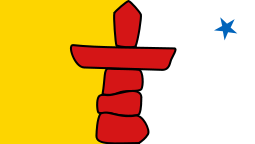Flag of Nunavut
 | |
| Proportion | 9:16 |
|---|---|
| Adopted | 1 April 1999 |
The official flag of Nunavut was proclaimed on 1 April, 1999, along with the territory of Nunavut in Canada. It features a red inuksuk—a traditional Inuit land marker—and a blue star, which represents the Niqirtsuituq, the North Star, and the leadership of elders in the community. The colours represent the riches of the land, sea and sky. It was adopted following a process where input was sought from local communities and submissions were solicited from the Canadian public.
Symbolism
The flag of the Canadian territory of Nunavut consists of gold and white fields divided vertically by a red inuksuk with a blue star in the upper fly. The colours blue and gold were selected to represent the "riches of land, sea, and sky", while red is used to represent Canada as a whole. The inuksuk, which divides the flag, is a traditional stone monument used to guide travellers and to mark sacred sites. In the upper fly, the blue star represents the North Star (Niqirtsituk), an important object due to its key role as a navigational beacon, and as symbolically representing the wisdom and leadership of community elders.[1]
History
The process of creating a flag for Nunavut began prior to its creation as a territory in 1999. This created significant excitement in the vexillographic community, as it was the first change in the map of Canada since Newfoundland became a province in 1949 and was being created in a region with little flag history.[2] In deference to the elders of the Inuit communities of Nunavut, the development of both the Nunavut flag and coat of arms was guided by their input. The process sought to give the public an opportunity to offer input into the colours and symbolism of the flag as well as to give local artists an opportunity to participate. Led by the Chief Herald of Canada, a group developing the flag visited a number of communities to seek input and learn about local culture, including Rankin Inlet, Baker Lake, Cape Dorset, Iqaluit, and Pangnirtung.[1]
The group then put out a call for submissions across all of Canada, and received over 800. These submissions were reviewed and winnowed by a committee made up of artists and local elders who chose ten finalists. From the symbols and colours of these ten finalists, five draft designs of the flag were developed. They were assisted in drafting these by local Inuit artist Andrew Qappik. The final version of the flag was reviewed and accepted by the commission responsible for its adoption as well as the Governor General of Canada and Queen Elizabeth II.[1] It was officially unveiled on 1 April 1999, the day when both the territory and government of Nunavut became official.[3]
Following its adoption, the flag has been criticized for vexillological reasons. Specifically, it has been criticized for having too many colours, the placement of the star at the end of the flag, the use of gold and white as the background field, and the use of a black outline around the inukshuk.[2]
See also
References
- 1 2 3 "Creation of the coat of arms and flag of Nunavut". Heraldry. Governor General of Canada. 2009-04-30. Retrieved 2016-11-29.
- 1 2 Orenski, Peter J. "THE NUNAVUT FLAG – A Vexillographer's Perspective". Retrieved 2009-06-27.
- ↑ Dahl, Jens; Hicks, Jack; and Jull, Peter (2000). Nunavut: Inuit regain control of their land and their lives. International Work Group for Indigenous Affairs. p. 96. ISBN 978-87-90730-34-5.
External links
- Arms and flag of Nunavut in the online Public Register of Arms, Flags and Badges